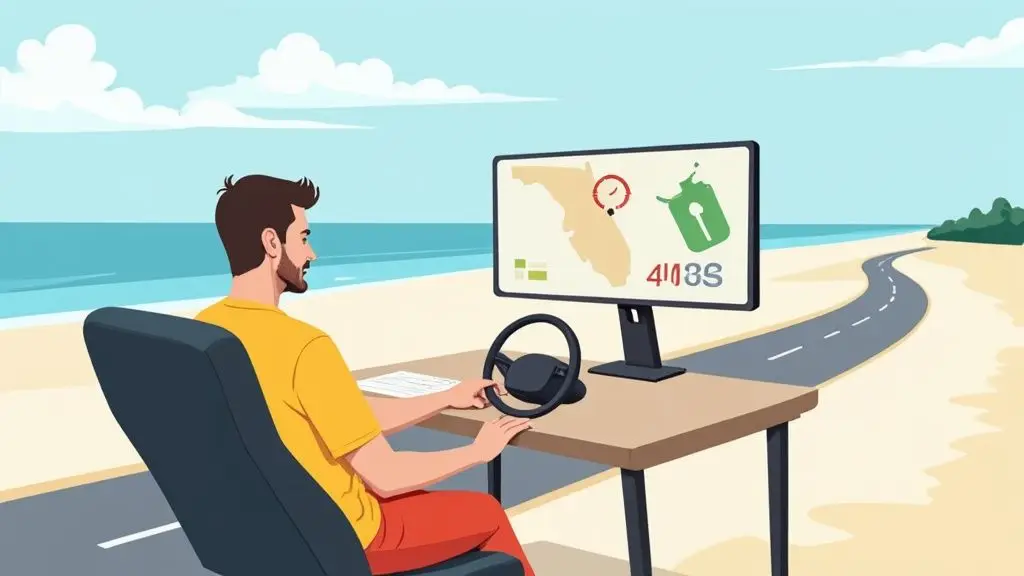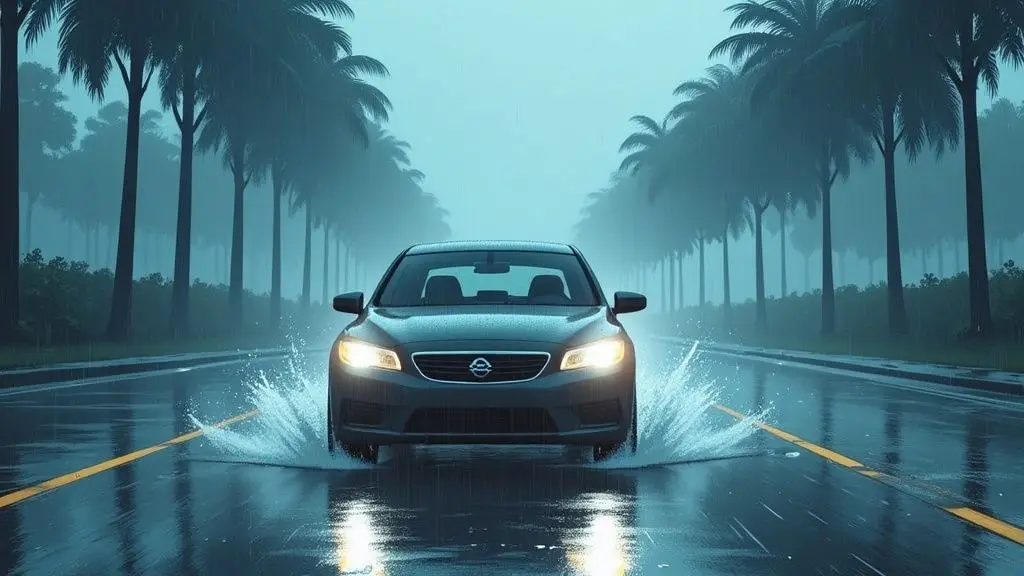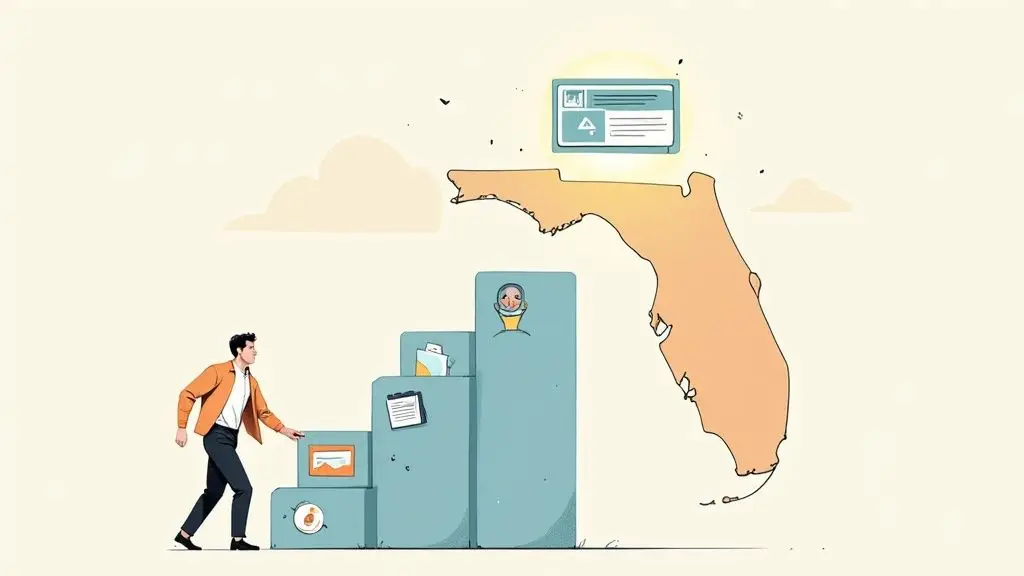Right-of-way isn’t something you take; it’s something you give. Truly grasping the right of way rules at intersections is the cornerstone of defensive driving. It helps create predictable patterns that prevent chaos and collisions on Florida’s busy roads.
Why Understanding Right of Way Is Crucial for Safety

Picture a busy crosswalk. People don’t just walk into traffic assuming cars will stop for them. They look, they wait, and they cross only when it’s safe. It’s the same for drivers. You have to be ready to yield, even if you technically have the right to go. This fundamental shift in mindset—from “taking” to “yielding” the right of way—is what makes a safe driver.
These rules aren’t just polite suggestions. They are the legal and practical glue holding our traffic system together, keeping intersections from turning into a complete free-for-all. Getting it wrong or aggressively insisting on your “right” can lead to serious, even tragic, outcomes.
The High Stakes of Intersection Safety
The statistics paint a sobering picture. Collisions at intersections are a massive problem, accounting for roughly one-quarter of all traffic deaths in the United States and nearly half of all crash injuries. With almost 6.1 million police-reported traffic crashes in a recent year, a huge chunk of them happened right where these rules were either ignored or misunderstood.
This is why getting these concepts down is about so much more than just passing your driving test. It’s about protecting yourself, your passengers, and every other person on the road. This knowledge is a vital piece of the puzzle for traffic safety for all drivers.
More Than Just Rules—It’s a System of Trust
Our entire traffic system runs on a shared understanding. It’s built on trust. When you follow the rules, you’re clearly communicating your next move to everyone around you, which keeps things predictable. Shatter that trust by blowing through a stop sign or failing to yield on a left turn, and you can cause a wreck in the blink of an eye.
At its core, right of way is a system of organized yielding. The goal isn’t to be first—it’s to ensure everyone gets through the intersection safely and efficiently, without conflict or confusion.
Understanding how fault is determined in car accidents really drives home the legal weight of these rules. Failing to yield is one of the first things investigators look for when assigning liability after a crash. This guide will break down these crucial rules so you can navigate every intersection with clarity and confidence.
Navigating Intersections With Traffic Signals
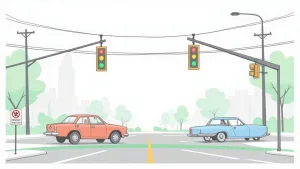
Traffic lights bring a sense of order to our busiest intersections, but they’re communicating a lot more than just “stop” and “go.” A green light isn’t a free pass to fly through; it’s simply permission to proceed when it’s safe. Getting a firm grasp on the nuances of these signals is the key to mastering right-of-way and staying safe on the road.
Too many drivers see solid green and assume it gives them total control. The reality is that it’s a conditional “go.” It means you can drive straight or turn right, but if you’re making a left turn, you absolutely must yield to all oncoming traffic. This simple misunderstanding is behind a shocking number of serious T-bone collisions.
Protected Turns vs. Unprotected Turns
The first thing you need to figure out at a signal is whether your turn is “protected” or “unprotected.” This one concept is what determines who has to yield.
- Protected Turn: This is your green arrow. When you see a green arrow, you have the exclusive right-of-way to make your turn. Oncoming traffic will have a red light, so the path is cleared specifically for you. It’s the clearest, safest signal you can get.
- Unprotected Turn: This is your classic solid green light. When you’re turning left on a solid green, you can pull into the intersection, but you do not have the right-of-way. You have to wait for a safe gap in the oncoming traffic before you can complete your turn.
Think of it this way: a green arrow is like a VIP pass at a concert—it ushers you right to the front. A solid green light is more like a general admission ticket; you can get in, but you have to wait your turn and yield to those with priority access (in this case, oncoming traffic).
The Flashing Yellow Arrow Explained
You’ve probably noticed more and more intersections in Florida are using a flashing yellow arrow for left turns. This signal was specifically designed to be less confusing and improve safety. Its meaning is simple: you can turn left, but only after yielding to oncoming vehicles and pedestrians.
In practice, a flashing yellow arrow works just like a solid green light for turning drivers. It just puts extra emphasis on the “yield” part, acting as a constant reminder that oncoming traffic still has a green light and owns the right-of-way. Never try to rush a turn on a flashing yellow; your only job is to wait until the coast is completely clear.
A huge mistake drivers make is treating a flashing yellow arrow like a regular yellow light and trying to “beat the red.” That’s not what it’s for. A flashing yellow means yield and proceed with extreme caution—it is not a warning that the light is about to change.
The Rules for Turning Right on Red
In Florida, you can generally make a right turn after stopping at a red light, but there are some non-negotiable rules. First and foremost, you have to come to a complete stop behind the white line. No rolling stops allowed.
After stopping, you must yield to everyone. And I mean everyone. This includes:
- Oncoming traffic that has a green light (including cars making U-turns).
- Pedestrians in the crosswalk, whether it’s marked or not.
- Cyclists riding in a bike lane or on the road.
Only after you are 100% certain the intersection is clear of all other traffic can you safely make your turn. Keep an eye out for signs that say “No Turn on Red,” because ignoring one of those is an easy way to get a ticket or cause a crash. Of course, proper signaling is also a must. You can learn more about the legal requirements in our guide on when to use turn signals to make sure everyone knows what you’re planning to do.
Finally, never forget your duty to pedestrians. Even if you have a green light, you must yield to anyone legally in a crosswalk. If a person is crossing with the “Walk” signal, they have the absolute right-of-way, and you have to wait until they are safely across before you move.
Decoding the Rules for Stop Sign Intersections
While traffic lights give us direct commands, intersections with stop signs rely on drivers sharing a common understanding of the rules of the road. That little bit of hesitation at a four-way stop or a moment of confusion at a T-intersection can quickly escalate into a dangerous situation.
Let’s break down these common scenarios into simple, repeatable rules so you can approach any stop sign with confidence.
The most common setup is the two-way stop. In this case, traffic on the smaller, minor road gets a stop sign, but the cross-traffic on the major road doesn’t. The rule couldn’t be simpler: you must come to a complete stop and yield to every single vehicle on the main road. Only when you have a safe gap should you proceed.
The All-Way Stop Hierarchy
The four-way stop (or all-way stop) is where things get a bit more interesting and where understanding the right of way rules at intersections is critical. Think of it as a quick, polite conversation between drivers. When everyone knows the script, it works beautifully.
There are two golden rules that keep everything in order:
- First to Arrive, First to Go: This is the big one. The very first vehicle to get to the intersection and make a complete stop gets to go first. Simple as that.
- Yield to the Driver on the Right: If two cars pull up at the exact same moment, the driver on the left must yield to the driver on their immediate right.
This “yield-to-the-right” rule is the universal tiebreaker. It removes all the guesswork. For a more detailed look at how this plays out in different situations, you can check out our in-depth guide to four-way stop rules.
To make it even clearer, here’s a quick reference table for those head-scratching moments at a four-way stop.
Who Goes First at a Four-Way Stop
| Scenario | Who Has the Right of Way | Action Required by Other Drivers |
|---|---|---|
| One vehicle arrives first | The first vehicle to come to a complete stop. | All other drivers must wait for the first vehicle to clear the intersection. |
| Two vehicles arrive at the same time (head-to-head) | Both can proceed straight. If one is turning left, they must yield. | Yield if you are the one turning left across the path of the oncoming car. |
| Two vehicles arrive at the same time (at a right angle) | The vehicle on the right has the right of way. | The vehicle on the left must wait for the vehicle on the right to proceed. |
| All four vehicles arrive at the same time | The vehicle furthest to the right begins the rotation, proceeding counter-clockwise. | Drivers must wait their turn, yielding to the driver on their immediate right. |
Following this simple hierarchy keeps traffic moving safely and predictably. It’s all about observing, knowing your place in the sequence, and proceeding with caution.
Understanding T-Intersections
A T-intersection is exactly what it sounds like—one road ends where it meets a through road, forming a “T” shape. The rule here is absolute and very easy to remember.
All traffic on the terminating road must yield to all traffic on the through road.
It makes no difference whether you’re turning left or right from the road that ends. The cars already on that through street always have the right of way. You have to wait for a safe opening. Think of the through road as a flowing river; you can’t just dive in. You have to wait for a clear space to merge safely into the current.
The infographic below gives a great visual breakdown of how to make decisions at these common stop sign intersections.
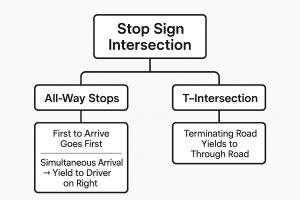
As you can see, the “first come, first served” principle is the foundation, and the “yield to the right” rule is the essential backup plan for when drivers arrive together.
Putting It All Together: A Practical Guide
Applying these rules in the real world is all about observation and clear communication. As you pull up to a four-way stop, the first thing you do after stopping is scan to see who got there before you. If you were clearly first, you’re good to go (cautiously, of course).
But what if you and another car arrive at the same time? It’s still straightforward.
- A car to your right arrives with you: You wait. They have the right of way.
- A car to your left arrives with you: It’s your turn. You have the right of way, but it’s always smart to make quick eye contact to be sure they see you and are waiting.
- An oncoming car arrives with you: If you’re both going straight, you can typically go at the same time. But if one of you is turning left, that driver must yield to the one going straight.
This sequence eliminates that awkward “you go, no you go” dance that can bring an intersection to a standstill. The trick is to follow the rules, communicate with other drivers (a nod or a hand wave goes a long way), and always put safety ahead of speed.
Navigating Uncontrolled Intersections and Yield Signs
While traffic signals and stop signs give us clear-cut instructions, some intersections are completely bare. These “uncontrolled” intersections can feel like the Wild West of driving because they don’t have any signs or signals to direct traffic. They operate entirely on a shared, unspoken understanding of right-of-way.
Think of pulling up to an uncontrolled intersection as a quick, polite negotiation with other drivers. Your first move is always to slow down and prepare to stop. If another vehicle is already in the intersection when you get there, they automatically have the right of way. You wait your turn.
The Tiebreaker: Who Goes First?
But what happens when two cars arrive at the exact same time? This is where a simple, universal rule kicks in: yield to the vehicle on your right.
If a car is approaching from your right-hand side, you let them go first. If the car is on your left, the right of way is technically yours, but you should always proceed with a healthy dose of caution. This rule is the bedrock of traffic flow at these intersections, preventing a chaotic free-for-all.
What a Yield Sign Really Means
A yield sign is a step up from an uncontrolled intersection, but it’s not as demanding as a stop sign. It’s a warning to slow down and give the right-of-way to any traffic on the cross-street—that includes cars, pedestrians, and cyclists. You only have to come to a complete stop if it’s necessary to avoid a collision.
Here’s a simple way to remember the difference:
A yield sign asks a question: “Is the coast clear?” A stop sign gives a command: “Wait until the coast is clear.”
The key is to be prepared. As soon as you spot a yield sign, you should be scanning for oncoming traffic and ready to hit the brakes. You are giving up the right-of-way, so never force another driver to slow down or swerve to avoid you. For other types of intersections that rely on yielding, like traffic circles, our guide on how to navigate roundabouts has some great pointers.
The Danger When Rules Are Ignored
Unfortunately, not every driver respects these critical rules. Violating right-of-way is a leading cause of nasty collisions across the country.
Consider the intersection of Lalor Street and State Route 129 in Trenton, NJ, where crashes shot up by 16.7% in just one year. It was even worse at Route 7 and Hickory Road in Niskayuna, NY, which saw a 25% jump in crashes during the same timeframe.
These numbers tell a sobering story: you can never just assume the other driver will do the right thing and yield. Always be a defensive driver. Scan every intersection, try to make eye contact with other drivers, and be ready to stop for someone who barrels through. Your safety relies not just on knowing the rules, but on anticipating that others might break them.
Sharing the Road with Pedestrians and Emergency Vehicles

The intricate dance of yielding and proceeding at intersections isn’t just about other cars. Intersections are shared spaces. As a driver, you have a huge responsibility to look out for vulnerable road users and clear the way for first responders. Getting these specific right of way rules at intersections right isn’t just a suggestion—it’s a critical part of safe driving.
This duty is about more than just checking for other vehicles; it demands a heightened awareness of everyone using our roads. Failing to yield to a pedestrian or an ambulance can lead to consequences far more devastating than a simple fender bender.
Your Duty to Pedestrians and Cyclists
In Florida, keeping pedestrians safe is a top priority. Drivers are legally required to yield to anyone on foot who is in a crosswalk. It doesn’t matter if that crosswalk is painted with bright white lines or is just an unmarked extension of the sidewalk at an intersection—the rule is the same.
In a collision, the responsibility almost always lands on the motorist. Even if a pedestrian is crossing improperly, drivers have a duty to exercise due care to avoid hitting them. Think of it as a hierarchy of protection on the road: the more vulnerable the person, the greater your responsibility is to keep them safe.
Cyclists also have a key spot in this hierarchy. Under Florida law, a person on a bicycle has all the same rights and responsibilities as someone driving a car. That means you have to treat them just like another vehicle.
- Don’t cut them off when you’re making a turn.
- Give them plenty of room when you pass.
- Yield to them at intersections just like you would for another car.
Ignoring a cyclist’s right to the road isn’t just dangerous; it’s a direct violation of state law.
The Absolute Mandate for Emergency Vehicles
The moment you hear a siren wail or see the flashing lights of an emergency vehicle, the normal rules of the road change instantly and dramatically. Your primary, non-negotiable legal duty is to yield the right-of-way. This isn’t a suggestion; it’s an absolute command.
The sound of a siren is an immediate order to clear a path. Any hesitation can cost precious seconds in a life-or-death situation, making your swift, correct action a vital part of the emergency response itself.
When you see or hear an emergency vehicle, you have to take specific, predictable steps to clear the road. Panicking or getting confused only creates more danger, so knowing exactly what to do is crucial.
How to Properly Yield to Emergency Responders
Your goal is to create an open, clear lane for the emergency vehicle to get through. The universal procedure is simple: pull over to the right and stop.
Follow these steps every time:
- Signal Your Intent: Flip on your right turn signal immediately. This shows other drivers and the emergency vehicle operator that you see them and are yielding.
- Move to the Right: Calmly and safely steer your vehicle as far to the right-hand side of the road as you can.
- Come to a Complete Stop: Don’t just slow down. Bring your car to a full stop and wait until the emergency vehicle is completely past you.
- Stay Put: Don’t pull back into traffic right away. Wait a few seconds to make sure another emergency vehicle isn’t following close behind the first one.
While first responders have special privileges, their safety—and yours—depends on everyone knowing the rules. Missteps can lead to tragic accidents involving negligent driving of ambulance vehicles and other responders.
Data shows that small changes can make a huge difference. For example, a study of 50 intersections found that implementing solutions like better signal timing and giving pedestrians a head start reduced the risk of conflicts by an average of 85%. These kinds of smart infrastructure upgrades, combined with alert driving, are proving how we can make our intersections safer for everyone.
Applying Defensive Driving at Every Intersection
Knowing the traffic laws is one thing. Actually using them to stay safe on the road? That’s a completely different skill.
Mastering the right-of-way rules at intersections is only half the battle. The other, and arguably more important half, is driving with a defensive mindset that puts your safety ahead of everything else. It’s about turning what you know into a real-world shield.
The core idea is simple but incredibly powerful: never assume another driver will do the right thing. Just because the law says you have the right-of-way doesn’t mean the other driver sees you, agrees, or is even paying attention. You have to be ready for them to make a mistake.
Building a Proactive Safety Buffer
Defensive driving isn’t about being timid or hesitant. It’s about being smart. It means you’re constantly scanning your surroundings, looking for potential problems before they happen, and always keeping a safe distance—a “buffer”—around your car. This simple shift in thinking moves you from just reacting to traffic to actually controlling your own safety.
Developing this mindset means making a few key habits second nature every single time you pull up to an intersection, no matter who legally gets to go first.
The real goal of defensive driving is to yield the right-of-way whenever it helps you avoid a crash. It’s far better to give up a few seconds than to be “dead right” in an accident report.
This philosophy is your ultimate safeguard. It’s the final layer of protection that keeps you safe when the rules fail because of someone else’s bad decision or distraction.
Actionable Habits for Intersection Safety
Turning theory into practice takes conscious effort, at least until it becomes automatic. Start by focusing on these defensive driving tactics every time you get behind the wheel. They’re simple, effective, and can easily be the difference between a close call and a serious collision.
Here are the essential habits you need to build:
- Scan Systematically: Before you enter any intersection—even on a green light—look left, right, and then left again. That final glance back to the left is critical, as it catches any vehicle that might have entered the picture while you were looking right.
- Make Eye Contact: Whenever you can, try to make eye contact with other drivers, cyclists, or pedestrians. A quick nod or hand wave confirms that they see you and know what you’re about to do, which gets rid of dangerous guesswork.
- Cover Your Brake: As you approach an intersection, especially one where your view is blocked or another car is waiting, take your foot off the gas and hover it over the brake pedal. This simple move can shave precious milliseconds off your reaction time if you need to stop suddenly.
- Eliminate All Distractions: Intersections are complex and demand your full, undivided attention. Put your phone down, lower the music, and pause your conversation. A single moment of distraction is all it takes for a situation to go wrong.
By making these techniques a consistent part of your driving routine, you’ll transform your knowledge of right-of-way into a powerful, instinctual habit. You learn to expect the unexpected, protect yourself from others’ mistakes, and make sure you get where you’re going safely.
Answering Common Right of Way Questions
Even when you know the basics, the road has a way of throwing curveballs. Certain situations at intersections can make even the most seasoned drivers pause and question who should go first. Let’s tackle some of the most frequent questions we hear from Florida drivers.
Getting a clear handle on these specific scenarios will give you the confidence to navigate tricky intersections safely and correctly.
Who Has the Right of Way in a Parking Lot?
Parking lots might be private property, but they aren’t the wild west. The same core traffic principles apply to prevent chaos. The best way to think about it is to see the main, wide lanes as the main roads and the smaller feeder lanes between parking stalls as side streets.
Following that logic, cars already moving in the main thoroughfares have the right of way over anyone pulling out of a parking spot. So, if you’re backing out or pulling forward from a space, you must yield to all cross-traffic. For any unmarked intersections within the lot, the old standby rule applies: yield to the driver on your right. And above all, pedestrians always have the right of way—be extra vigilant, as they can pop out from between parked cars without warning.
What if Two Cars Are Turning Left at the Same Time?
This one causes a lot of hesitation. Picture this: you and a driver coming from the opposite direction both arrive at an intersection, and you both want to turn left. Who goes?
After yielding to any oncoming traffic going straight, you can both typically turn at the same time. The trick is to execute the turn properly. Each driver should turn into their corresponding lane on the new street, passing in front of the other car. You should never have to cross behind the other turning vehicle. This little dance allows traffic to flow efficiently without either of you getting in the other’s way.
Does a Funeral Procession Have the Right of Way?
Yes, absolutely. Florida law grants the right of way to organized funeral processions. Once the lead vehicle—which usually has flashing lights or a flag—legally enters an intersection, the entire line of cars behind it gets to follow without interruption.
This is a big one: the procession can continue through the intersection even if the light turns red. As another driver, you are legally required to stop and yield to the entire procession until the very last car has passed. It’s a sign of respect, but it’s also the law.
Navigating Florida’s traffic laws can be complex, but you don’t have to do it alone. If you’ve received a ticket, BDISchool offers a state-approved Basic Driver Improvement course to help you manage points and improve your driving record. Learn more about our BDI course.
